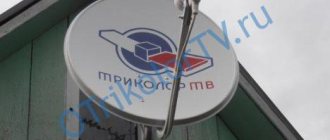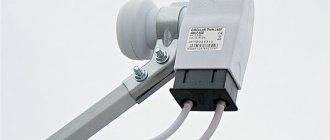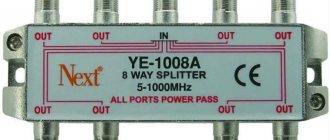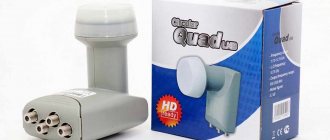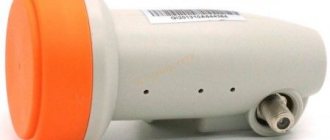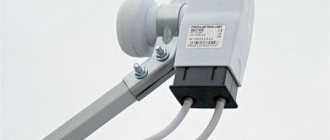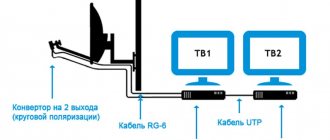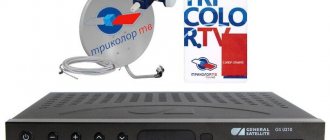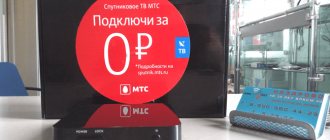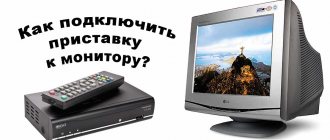Looking at the antenna unit for receiving satellite broadcasts, many users mistakenly consider the main part to be a large and noticeable dish. In practice, the most important component is the Tricolor converter. It is he who is engaged in converting radio waves reflected from the deflector into an output signal to the receiver. Understanding the operating principle of this unit will allow you to choose the best converter for Tricolor TV and decide which model is worth buying to connect the required number of TVs in the house.
Purpose, design and principle of operation of the converter
The converter for Tricolor TV is a compact, lightweight device. It is considered to be a single unit. But in practice, a converter with 2 outputs, 4 outputs or an advanced device with 8 outputs consists of pairs of functional blocks. It all works as follows.
- The signal coming from the satellite is amplified. A separate converter block is responsible for this. Its characteristics directly indicate the ability to generate high-quality indicators of the output signal. The noise level parameter, measured in decibels, formally indicates the distortion introduced by the device. Based on a value of 0.3 and below, you can choose a converter for Tricolor TV HD that can provide excellent picture quality.
- The second block converts the wave signal into the parameters necessary for the operation of the receiver. It also brings the broadcast to the standard adopted for conditional access televisions and other equipment capable of working with satellite signals.
Within the framework of one converter, a variety of construction schemes from the described modules can be implemented. The minimum characteristics of the final node that is needed for Tricolor is a pair of an amplifier and a wave converter with one output. The price of such a device is accessible to literally every consumer. If you need to send a signal to 2 TVs or more, you need to buy a more complex converter model.
Test of circular converters for Tricolor and NTV+
Test of converters for Tricolor and NTV+, available at the time of testing in the Sputnik-Region store.
Quite often, buyers ask which converter to choose for NTV Plus or Tricolor. Different manufacturers, quite a big difference in price. To make it easier to decide on the choice of converter, we conducted a small comparative test of the converters we currently have.
You can buy inexpensive circular polarization converters for NTV+ and Tricolor here
Testing was carried out on the Supral 0.55m antenna, the Express AT1 satellite at a position of 56 degrees east, and the GM Wisard HD receiver.
Indications of level and quality cannot be considered reference and cannot be compared with indications of level and quality on receivers of other models, and with the use of antennas of different diameters. The purpose of the test is to compare the gain of converters. These readings are used as comparative readings, to compare the parameters of converters of different models at a specific point in time, on a specific receiver model.
Frequency-12226, polarization-H
Frequency-12245, polarization-V
Based on this small comparative test, we can draw a conclusion about the advisability of using one or another converter, depending on its cost, gain and antenna diameter in each specific case.
As you can see, there is not much difference between the converters in the quality of reception, and at first glance, it is better to take a cheaper converter, for example Selenga or DVS. But it should be taken into account that if you are on the border of the coverage area, then it is better to take a converter with the best characteristics, although it is more expensive. With a weaker signal, the difference in gain will be more noticeable, and there is a risk that using a cheaper converter will not achieve an acceptable signal level. Also, more expensive converters, as a rule, have a higher quality design and a better element base, which extends its service life, especially in adverse conditions.
Based on practice, I would advise in such cases to use circular converters from the manufacturer Galaxy Innovations - GI-121 (converter for 1 output), GI-124 (converter for 2 outputs), and converter for 2 outputs SLWI-52E.
Converters DVS-C101, DVS-102, DVS-104 are strong averages, having quite acceptable characteristics and good operational reliability. But they are still less reliable than GI converters. The use of these converters is fully justified in an area of good reception.
If you have an antenna with a diameter of 0.8 m, and in your region, judging by the coverage area, signal reception is possible with an antenna with a diameter of 0.6 m, then, in order to save money, you can use a cheaper converter, albeit with slightly worse characteristics.
As for the reliability of less famous converters, they are all checked before shipping, and if a malfunction occurs, we immediately replace the converter.
If the antenna is small in diameter, then it is better to take a more expensive converter, but with the highest gain.
Converter for NTV+, Tricolor for 1 output DVS-C101
Converter for NTV+, Tricolor for 1 output GI-121
Converter for NTV+, Tricolor for 2 outputs DVS-C102
Converter for NTV+, Tricolor for 2 outputs SLWI-52E
Converter for NTV+, Tricolor for 2 outputs SELENGA GK-126
Converter for NTV+, Tricolor for 2 outputs DVS-104
Converter for NTV+, Tricolor for 2 outputs GI-124
Converter parameters for Tricolor TV
In addition to the already indicated noise level, the head for the Tricolor plate is selected according to a number of parameters. Some of them are critical for receiving broadcasts from this particular satellite television provider.
Frequency range
Each converter operates with a specific frequency band. It is better for Tricolor to choose a device that meets the broadcast standard of all Russian satellite television providers - this is the so-called KU range.
Advice! Products with such markings can be offered both by frankly handicraft Chinese manufacturers and by famous brands. Practice shows that malfunctions occur very rarely in models of the mid-price category, so it’s definitely not worth focusing on a high price tag and brand name.
Polarization
Tricolor broadcasts in circular polarization. Converters of another type, linear, are not suitable for receiving broadcasts from this provider. Polarization is indicated directly on the device body. The inscription Circular means circular, and Universal means most often not suitable for Tricolor subscribers.
Number of outputs
As mentioned above, to watch programs on one TV, a converter with a single output is sufficient. If there are two or more TVs in the house, it is recommended to buy a device with the required number of ports. There is no need to skimp on this feature. Splitters - dividers in some cases cannot provide adequate signal quality to the consumer.
Noise level
Today the Tricolor company offers channels in UHD quality for viewing. The requirements for receiving such a signal are very high. If a subscriber plans to subscribe to HD and UHD channels, he will need a low noise LNB (LNA) converter.
Many manufacturers claim a noise level of 0.1-0.2 dB for such a device. However, this is most often a marketing ploy, and in practice the figure ranges from 0.3 to 0.5 dB. It is this range that you should focus on in order to buy a device with the optimal price-performance ratio. A simpler converter is suitable for receiving regular broadcasts. The permissible noise level ranges from 3 to 5 dB. The price of such products is very affordable.
Basic parameters of converters for receiving satellite signals
Scientific sources define a converter as a receiver for processing a satellite signal. In fact, this is not one, but two devices in one monolithic block.
One of them is designed to enhance the signal coming from the satellite. Its operation is characterized by the level of (additional) noise produced. Everything is simple here - the lower the values, the less interference there will be during transmission. In modern devices, this parameter ranges from 0.3 to 0.5 dB. These are quite adequate indicators that fit the definition of “low noise device” or LNA (English abbreviation). Another name associated with the amplifier is the satellite converter - LNB or low noise unit.
Important: not very conscientious manufacturers indicate more attractive data (0.1 - 0.3 dB), but they should not be taken as truthful.
A second device is needed to convert wave frequencies. It leads them to parameters under which the signal can be transmitted to a receiver or TV with a conditional access module without instant attenuation in the cable.
Important: converters are only capable of operating with certain frequency ranges. This characteristic largely determines which converter is best to choose for Tricolor. The device must process the frequencies on which Russian operators broadcast - in the range from 10.7 to 12.75 GHz (the so-called Ki-band).
Polarization of converters for Tricolor
Having decided on the noise characteristics and operating range of the unit, you can move on to the next important parameter - the polarization of the satellite signal. The average satellite subscriber needs to know one thing - that it can be circular or linear (it differs among different operators).
Since Tricolor TV works with a circularly polarized signal, the converter must be selected accordingly. This can be concluded from the inscription “Circular” in the block name. On the contrary, a head marked with the word “Universal” is not initially suitable.
Appearance of Tricolor converters and number of outputs
The LNB unit, hermetically sealed in a metal casing, is placed in an L-shaped plastic case with a rounded cap at the end (hence the common name “head”). The mechanism is mounted on the remote rod of the antenna (so that the signal collected by the dish is focused directly on it). The unit is connected to the receiver via a coaxial cable.
Just by the appearance of the devices, you can determine that they differ in the number of connectors to which the coaxial cable is connected. The classic case is a converter for Tricolor TV with 1 output. An increase in the number of plugs makes it possible to connect not one TV to one satellite dish, but two or even more. Each of them will be able to work in tandem with its own receiver, that is, completely autonomously.
We recommend that you find out why Tricolor TV clients should sign a subscription agreement and where to find the form.
Read: how to install a Tricolor smart card and what it is needed for.
The number of outputs on the LNB can be judged by its markings:
- SINGLE - one;
- TWIN - two;
- QUAD - four;
- OCTO - eight.
Converter or splitter: which is better to choose?
Splitters, also known as signal dividers, are simple devices with one input and several outputs. In the eyes of many consumers, they look like a cheap alternative to laying cable lines and buying a converter with the required number of outputs for TVs installed in the house. In practice, using splitters can lead to negative results. Broadcasts in HD quality are extremely sensitive to signal level. For splitters, it is lower at each output than at the input. As a result, the following happens:
- some TVs do not show all channels of an active subscription;
- On HD channels, video glitches occur, the picture has artifacts, freezes, and crumbles.
Important! It is recommended to use the splitter wisely. The subscriber will not notice any negative consequences of his connection if he watches only channels in normal quality and sends the signal to two TVs. But when the network of consumers in the house is large, you want to watch broadcasts in HD format; you simply cannot do without purchasing a converter with the required number of outputs.
Which is better – a multi-output converter or a splitter?
The price of the converter will directly depend on how many TVs can be connected to it. Obviously, a satellite converter with 4 outputs for Tricolor will cost more than a similar device with two connectors and cheaper than with eight.
In addition, ideally, there should be a separate cable from each F-connector of the head to each TV. This only increases the overall cost of multiple connections, especially when you factor in the additional installation. In this case, craftsmen suggest saving money by installing special cable dividers (splitters) directly on the approach to the receivers.
Practice shows that this method works with drawbacks. A decrease in the quality of signal transmission to the receiver is manifested in the following moments:
- one of the TVs does not show all the channels of the paid package;
- the picture, especially on HD channels, sometimes breaks up into squares, that is, “crumbles.”
Advice: as for Tricolor TV subscribers specifically, the 2-output converter is most popular with them due to the operator’s special offer. The server-client kit allows you to connect two TVs from one antenna and pay a single subscription fee.
Approximate prices for converters
Thanks to the achievements of Chinese and other industries, the price of the converter is continuously falling. Today you can buy:
- solutions with one output; for Tricolor, the SLWI-51EN model with an average price tag of 500 rubles is recommended;
- a device with two General Satellite TWIN outputs for an average of 780 rubles;
- solution for 4 outputs, model GSLF-54E with an average price tag of 1800 rubles.
For those who plan to equip a large house with TVs in every room, there is the Galaxy Innovations GI-128 OCTO model, which has as many as 8 independent outputs. At the same time, the device is low noise and suitable for receiving HD channels. The price tag for such a converter is about 2150 rubles.
However, most users prefer to take the easiest path. To buy a converter with optimal characteristics, just contact authorized dealers or a Tricolor subscriber service branch in your region. Experts will recommend a model that shows the best results in this particular area.
What else to pay attention to when choosing
Perhaps the most important criterion for the modern consumer is the cost of the converter. A completely logical question arises: is it worth overpaying for the best “head” for satellite TV? It's hard to answer definitively. Much depends on what region you live in. The satellite of the Tricolor TV provider occupies a position that is oriented towards your longitude. Therefore, it is mainly possible to achieve excellent signal quality in different regions of the Russian Federation.
This suggests that even inexpensive converters for Tricolor TV are capable of providing high-quality reception of TV channels. Low-cost devices will be available to all subscribers living in an area of less than 50 decibels. In such regions, converters of all price segments can provide good reception.
Today, many technicians offer subscribers to install several receivers on one satellite TV antenna at once. In theory, this will allow you to connect more than one TV. However, reception problems will appear. It makes more sense to buy a converter with 4 outputs or 8 connectors to connect several TVs. This allows you to achieve the highest quality signal.
You should not save on purchasing a converter. Buy original equipment from authorized dealers. Chinese analogues, which have impressive technical specifications, do not meet user expectations. In addition, they have a rather limited service life.
How to distinguish a high-quality converter from an ordinary fake? This is extremely easy to do. Turn on a TV channel broadcast in Full HD format. If the image becomes stratified and “squares” appear, this indicates poor-quality operation of the equipment. Savings can have an extremely negative impact on the quality of the broadcast image.
Don't forget that the converter is one of the key elements of satellite television broadcasting. Therefore, the poor quality of this device will cause a wide range of different problems. Many users, in an attempt to save as much as possible, buy equipment from unverified stores. This is a highly undesirable solution.
A high-quality image will be broadcast only if all elements of satellite equipment are configured properly. Therefore, you should not call unverified professionals. They can become a catalyst for various breakdowns. Check the quality of purchased goods, and also use the services of certified engineers. It is necessary to purchase converters that meet the stated technical parameters.
The easiest way to set up correct satellite broadcasting is to contact your Tricolor TV provider for help. Order equipment from this company, as well as satellite system installation services. The operator provides a guarantee for all devices and work performed by engineers.
Do not forget that the converter is selected in accordance with the number of TVs on which you want to tune satellite channels. Pay attention to the available connectors. It is necessary to buy models with Ku-band. The packaging of the selected equipment must be marked “Circle”.
How to check the converter during installation
Tricolor converters purchased from official dealers or ordered from the company's customer service branches are almost always of high quality. However, if the device was purchased from third-party companies, ordered from online stores, or purchased on global trading platforms, you should make sure that it is working. You can check the satellite dish converter as follows:
- install it on the deflector posts;
- connect a specialized device to the device, for example, Satfinder for setting up satellite dishes and check the indicator readings;
- If you do not have a setup device, switch the receiver to the signal indicator display mode and make sure the converter is working.
Important! It is worth immediately noting that a working device will always produce a non-zero level. Even when the antenna unit is not aimed at the satellite.
Another way to check the converter is to connect it to an already installed and correctly configured deflector and Tricolor receiver.
In case of any problems, lack of signal, reception of some channels, first eliminate all possible problems in the form of an incorrectly inserted card, old receiver firmware, damaged cables and other problems. Only then do they decide that the cause is a broken converter. This may be indicated by:
- some channels do not show with the error “No signal”;
- on the channel information banner, one of the indicators shows a normal value (signal strength), and the other (quality) shows zero.
The Tricolor converter cannot be repaired; the device must be completely replaced. It is recommended to order a high-quality, certified converter from authorized dealers or Tricolor customer service branches. But if you are confident in your ability to make the right choice, you can buy a suitable model from third-party sellers.
